Three eurozone countries are already in recession. In the next two quarters, the 1.7% drop in GDP should affect the entire single currency area. The most pessimistic forecasts even predict the collapse of the euro.
Sasin: “We will have to report higher VAT rates not only for electricity”. What are the products?
The forecasts of the European Central Bank (ECB), the International Monetary Fund (IMF), as well as the major commercial banks, are very gloomy for the euro area. In the second quarter, GDP growth was recorded by 08%, but only by 0.2% in the third. Three eurozone countries – Belgium, Latvia and Austria – are already in decline. Within the next six months it should settle at 1.7% for the whole area of the single currency. In the Netherlands, the recession is announced by Finance Minister Sigrid Kraag.
Consumer confidence has fallen so much that a recession is unlikely to be superficial
says Holger Schmieding, chief economist at German investment bank Berenberg.
The losses for the Europeans will be dramatic. To show how powerful the blow to Europe will be, I will say that our pre-pandemic and current forecasts differ by half a trillion euros
— said the head of the IMF, Kristina Georgieva, at the conference “Making Markets Work For People” in Brussels. According to the Fund, the euro area will grow by just 0.5% in 2023, with the economies of Germany and Italy expected to contract by 0.3% and 0.2%.
However, one of the world’s largest banks, the American Morgan Stanley, expects a drop of 0.2% in the euro area next year and even 0.7% in Germany, the largest economy.
Regardless of differences in predictions, one vote is common.
Don’t beat around the bush: 2023 will be more difficult than 2022
Georgieva, head of the IMF, said in Brussels.
Permacrisis
The economic crisis, and above all the financial one, could be much deeper than that of 2009, when the then head of the European Central Bank, Mario Draghi, announced that the common currency, the euro, was in danger of collapsing. Everything repeats itself. Head of economic programs at European Political Center think tank Georg Rielkes says EU is bogged down “permacrisis” – a constant and permanent crisis. Thomas Mayer, founder and director of the Flossbach von Storch Research Institute, believes that the next crisis will end this time with the collapse of the euro.
It’s worth looking at forecasts from a certain angle. Analyzes recently released by PKO show that since 2019 the German economy has grown by only 0.2%, and the entire euro area by 2.7%. Spain, governed by socialists and communists, is experiencing a real drama. Its economy shrank by 2% during this period. This means that it is at the level of the early 21st century. Spain did not recover the losses of the 2009 crisis until 2019, thus missing out on two decades of economic development. Now, together with the entire eurozone, it is entering another crisis: it is falling permacrisis.
Europe at two speeds
What does Poland look like in this context? Much. Since 2019, our economy has grown the most in the whole Union – by 9.2%. Lithuania follows with an increase of 7.6%. Our currency is doing relatively well. Its current exchange rate against the euro is exactly the same as it was a year ago. The dollar is a separate issue. Over the course of the year, the latter strengthened against almost all world currencies, including against the euro by about 10%. The Swiss franc is practically permanently more expensive than the European currency. It is from this perspective that the zloty should be viewed.
Naturally, the crisis in the eurozone will hit Poland. We are in an economic area, but very strong fundamentals should mitigate the effects of the blow the head of the IMF was talking about. In September, compared to the same period last year, industrial new orders were higher by as much as 44.1% and stood at the highest level in history. Including those from abroad for 43.8%. From this point of view, the weakening of the zloty is even beneficial for Polish producers.
We still have a very low unemployment rate – after the September correction it is 5.1%. The number of jobless people has not changed, only the job market has widened, thus a minimum increase of 0.3% after the correction.
No matter how we look at Poland and Europe, we can talk about a two-speed Union. We are developing and the eurozone is collapsing, it is immersed permacrisis. This is probably best reflected in the data from last year’s report from the European Central Bank. Since the 1970s, labor productivity has grown increasingly slowly in the current euro area countries. The situation has worsened especially since the 1990s. Now, labor productivity growth is at 1% per annum, and in some countries, like Spain, it has been at 0 for over a decade. Surprisingly enough, the growing number of people with higher education is not results in an increase in labor productivity.
Even in 2005, after the enlargement of the Union to 7 countries, it had the largest economy in the world. Today it is in third place, and the gap with the United States and China continues to widen, already reaching 500 billion dollars a year.
30 years ago, the list of the largest companies in the world included several dozen from the area of u200bu200bthe current EU. There are now 12, of which 2 in Ireland are de facto American. The largest company in the EU, German Volkswagen, is in 66th place.

